Chevrolet Captiva 2014 Owner's Manual

2014 Chevrolet Captiva Sport Owner Manual M
In Brief . . . . . . . . . . . . . . . . . . . . . . . . 1-1
Instrument Panel . . . . . . . . . . . . . . 1-2
Initial Drive Information . . . . . . . . 1-4
Vehicle Features . . . . . . . . . . . . . 1-16
Performance and
Maintenance . . . . . . . . . . . . . . . . 1-20
Keys, Doors, and
Windows . . . . . . . . . . . . . . . . . . . . 2-1
Keys and Locks . . . . . . . . . . . . . . . 2-1
Doors . . . . . . . . . . . . . . . . . . . . . . . . . . 2-8
Vehicle Security. . . . . . . . . . . . . . . . 2-9
Exterior Mirrors . . . . . . . . . . . . . . . 2-11
Interior Mirrors . . . . . . . . . . . . . . . . 2-13
Windows . . . . . . . . . . . . . . . . . . . . . 2-13
Roof . . . . . . . . . . . . . . . . . . . . . . . . . . 2-14
Seats and Restraints . . . . . . . . . 3-1
Head Restraints . . . . . . . . . . . . . . . 3-2
Front Seats . . . . . . . . . . . . . . . . . . . . 3-3
Rear Seats . . . . . . . . . . . . . . . . . . . . 3-8
Safety Belts . . . . . . . . . . . . . . . . . . . . 3-9
Airbag System . . . . . . . . . . . . . . . . 3-17
Child Restraints . . . . . . . . . . . . . . 3-30
Storage . . . . . . . . . . . . . . . . . . . . . . . 4-1
Storage Compartments . . . . . . . . 4-1
Additional Storage Features . . . 4-2
Roof Rack System . . . . . . . . . . . . . 4-3
Instruments and Controls . . . . 5-1
Controls . . . . . . . . . . . . . . . . . . . . . . . 5-2
Warning Lights, Gauges, and
Indicators . . . . . . . . . . . . . . . . . . . . 5-8
Information Displays . . . . . . . . . . 5-24
Vehicle Messages . . . . . . . . . . . . 5-28
Vehicle Personalization . . . . . . . 5-36
Universal Remote System . . . . 5-42
Lighting . . . . . . . . . . . . . . . . . . . . . . . 6-1
Exterior Lighting . . . . . . . . . . . . . . . 6-1
Interior Lighting . . . . . . . . . . . . . . . . 6-4
Lighting Features . . . . . . . . . . . . . . 6-6
Infotainment System . . . . . . . . . 7-1
Introduction . . . . . . . . . . . . . . . . . . . . 7-1
Radio . . . . . . . . . . . . . . . . . . . . . . . . . . 7-5
Audio Players . . . . . . . . . . . . . . . . 7-11
Phone . . . . . . . . . . . . . . . . . . . . . . . . 7-24
Climate Controls . . . . . . . . . . . . . 8-1
Climate Control Systems . . . . . . 8-1
Air Vents . . . . . . . . . . . . . . . . . . . . . . . 8-9
Maintenance . . . . . . . . . . . . . . . . . . . 8-9
Driving and Operating . . . . . . . . 9-1
Driving Information . . . . . . . . . . . . . 9-2
Starting and Operating . . . . . . . 9-14
Engine Exhaust . . . . . . . . . . . . . . 9-20
Automatic Transmission . . . . . . 9-21
Drive Systems . . . . . . . . . . . . . . . . 9-25
Brakes . . . . . . . . . . . . . . . . . . . . . . . 9-25
Ride Control Systems . . . . . . . . 9-28
Cruise Control . . . . . . . . . . . . . . . . 9-30
Driver Assistance Systems . . . 9-32
Fuel . . . . . . . . . . . . . . . . . . . . . . . . . . 9-35
Trailer Towing . . . . . . . . . . . . . . . . 9-40
Conversions and Add-Ons . . . 9-47
Vehicle Care . . . . . . . . . . . . . . . . . 10-1
General Information . . . . . . . . . . 10-2
Vehicle Checks . . . . . . . . . . . . . . . 10-3
Headlamp Aiming . . . . . . . . . . . 10-27
Bulb Replacement . . . . . . . . . . 10-27
Electrical System . . . . . . . . . . . . 10-30
Wheels and Tires . . . . . . . . . . . 10-37

2014 Chevrolet Captiva Sport Owner Manual M
Jump Starting . . . . . . . . . . . . . . . 10-66
Towing the Vehicle . . . . . . . . . . 10-70
Appearance Care . . . . . . . . . . . 10-74
Service and Maintenance . . . 11-1
General Information . . . . . . . . . . 11-1
Maintenance Schedule . . . . . . . 11-2
Special Application
Services . . . . . . . . . . . . . . . . . . . . 11-8
Additional Maintenance
and Care . . . . . . . . . . . . . . . . . . . . 11-9
Recommended Fluids . . . . . . . 11-12
Maintenance Records . . . . . . . 11-15
Technical Data . . . . . . . . . . . . . . . 12-1
Vehicle Identification . . . . . . . . . 12-1
Vehicle Data . . . . . . . . . . . . . . . . . . 12-2
Customer Information . . . . . . . 13-1
Customer Information . . . . . . . . 13-1
Reporting Safety Defects . . . . 13-12
Vehicle Data Recording and
Privacy. . . . . . . . . . . . . . . . . . . . 13-13
OnStar . . . . . . . . . . . . . . . . . . . . . . . 14-1
OnStar Overview. . . . . . . . . . . . . 14-1
OnStar Services . . . . . . . . . . . . . . 14-2
OnStar Additional
Information . . . . . . . . . . . . . . . . . . 14-5
Index . . . . . . . . . . . . . . . . . . . . . i-1

Introduction iii
The names, logos, emblems, slogans, vehicle model names, and vehicle body designs appearing in this manual including, but not limited to, GM, the GM logo, CHEVROLET, the CHEVROLET Emblem, and CAPTIVA are trademarks and/or service marks of General Motors LLC, its subsidiaries, affiliates,
or licensors.
This manual describes features that may or may not be on your specific vehicle either because they are options that you did not purchase or due to changes subsequent to the printing of this owner manual.
Please refer to the purchase documentation relating to your specific vehicle to confirm each of the features found on your vehicle.
Keep this manual in the vehicle for quick reference.
Using this Manual
To quickly locate information about the vehicle, use the Index in the back of the manual. It is an alphabetical list of what is in the manual and the page number where it can be found.
About Driving the Vehicle
As with other vehicles of this type, failure to operate this vehicle correctly may result in loss of control or an accident. Be sure to read the driving guidelines in this manual in the section called “Driving and Operating” and specifically
Driver Behavior on page 9-2, Driving Environment on page 9-2, and Vehicle Design on page 9-2.
Danger, Warnings, and
Cautions
{Danger
Text marked { Danger provides information on risk of fatal injury. Disregarding this information may endanger life.
Litho in U.S.A. |
© 2013 General Motors LLC. All Rights Reserved. |
Part No. 22893931 B Second Printing |
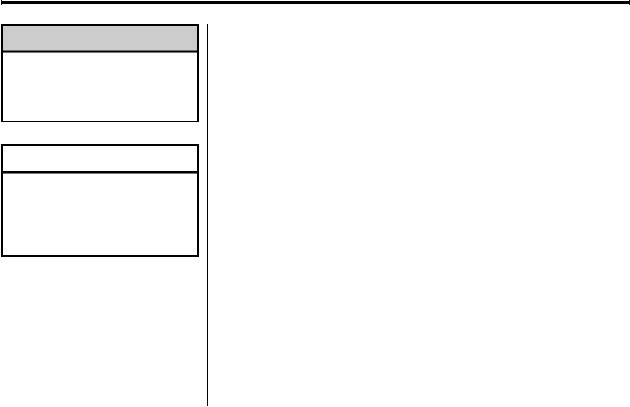
iv Introduction
{Warning
Text marked { Warning provides information on risk of accident or injury. Disregarding this information may lead to injury.
{Caution
Text marked { Caution provides information that may indicate a hazard that could result in injury or death. It could also result in possible damage to the vehicle.
A circle with a slash through it is a safety symbol which means “Do Not,” “Do not do this,” or “Do not let this happen.”
Symbols
The vehicle has components and labels that use symbols instead of text. Symbols are shown along with the text describing the operation or information relating to a specific component, control, message, gauge, or indicator.
M : This symbol is shown when you need to see your owner manual for additional instructions or information.
* : This symbol is shown when you need to see a service manual for additional instructions or information.
Vehicle Symbol Chart
Here are some additional symbols that may be found on the vehicle and what they mean. For more information on the symbol, refer to the Index.
9 : Airbag Readiness Light
# : Air Conditioning
! : Antilock Brake System (ABS)
v +/-: Audio Steering Wheel Controls
$ : Brake System Warning Light
" : Charging System
I : Cruise Control
B : Engine Coolant Temperature
O : Exterior Lamps
# : Fog Lamps
. : Fuel Gauge
+ : Fuses
3 : Headlamp High/Low-Beam Changer

Introduction v
j : LATCH System Child
Restraints
* : Malfunction Indicator Lamp
: : Oil Pressure
} : Power
/ : Remote Vehicle Start
> : Safety Belt Reminders
7 : Tire Pressure Monitor
d : Traction Control/StabiliTrak®
M : Windshield Washer Fluid

vi Introduction
2 NOTES

In Brief |
1-1 |
In Brief
Instrument Panel
Instrument Panel Overview . . . . 1-2
Initial Drive Information
Initial Drive Information . . . . . . . . 1-4
Remote Keyless Entry (RKE)
System . . . . . . . . . . . . . . . . . . . . . . 1-4
Remote Vehicle Start . . . . . . . . . 1-4
Door Locks . . . . . . . . . . . . . . . . . . . 1-5
Liftgate . . . . . . . . . . . . . . . . . . . . . . . . 1-6
Windows . . . . . . . . . . . . . . . . . . . . . . 1-6
Seat Adjustment . . . . . . . . . . . . . . 1-7
Second Row Seats . . . . . . . . . . . 1-9
Heated Seats . . . . . . . . . . . . . . . . . 1-9
Head Restraint
Adjustment . . . . . . . . . . . . . . . . . 1-10
Safety Belts . . . . . . . . . . . . . . . . . . 1-10
Passenger Sensing
System . . . . . . . . . . . . . . . . . . . . . 1-10
Mirror Adjustment . . . . . . . . . . . . 1-11
Steering Wheel
Adjustment . . . . . . . . . . . . . . . . . 1-12
Interior Lighting . . . . . . . . . . . . . . 1-12
Exterior Lighting . . . . . . . . . . . . . 1-13
Windshield Wiper/Washer . . . . 1-13
Climate Controls . . . . . . . . . . . . . 1-14
Transmission . . . . . . . . . . . . . . . . 1-15
Vehicle Features
Radio(s) . . . . . . . . . . . . . . . . . . . . . 1-16
Satellite Radio . . . . . . . . . . . . . . . 1-17
Portable Audio Devices . . . . . . 1-17
Bluetooth® . . . . . . . . . . . . . . . . . . . 1-17
Steering Wheel Controls . . . . . 1-17
Cruise Control . . . . . . . . . . . . . . . 1-18
Infotainment System . . . . . . . . . 1-18
Driver Information
Center (DIC) . . . . . . . . . . . . . . . 1-18
Rear Vision
Camera (RVC) . . . . . . . . . . . . . 1-19
Ultrasonic Parking Assist . . . . 1-19
Power Outlets . . . . . . . . . . . . . . . 1-19
Universal Remote System . . . 1-19
Performance and Maintenance
Traction Control/Electronic Stability Control . . . . . . . . . . . . 1-20
Tire Pressure Monitor . . . . . . . . 1-20 Engine Oil Life System . . . . . . 1-21 E85 or FlexFuel . . . . . . . . . . . . . . 1-21 Driving for Better Fuel
Economy . . . . . . . . . . . . . . . . . . . 1-21 Roadside Assistance
Program . . . . . . . . . . . . . . . . . . . . 1-22 OnStar® . . . . . . . . . . . . . . . . . . . . . 1-22
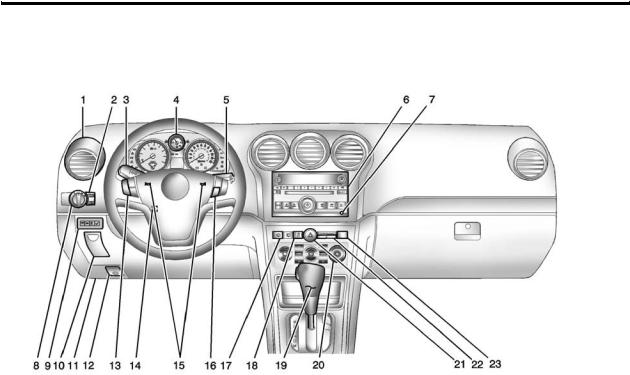
1-2 In Brief
Instrument Panel
Instrument Panel Overview

In Brief |
1-3 |
1.Air Vents on page 8-9.
2.Instrument Panel Illumination Control on page 6-4.
3.Turn Signal Lever. See Turn and Lane-Change Signals on
page 6-3.
4.Instrument Cluster on page 5-9.
5.Windshield Wiper/Washer on page 5-3.
6.AM-FM Radio on page 7-5.
7.Auxiliary Input Jack (If Equipped). See Auxiliary Devices on page 7-20.
8.Fog Lamps on page 6-4.
Exterior Lamp Controls on page 6-1.
9.Driver Information Center (DIC) Buttons. See Driver Information Center (DIC) on page 5-24.
10.Instrument Panel Storage on page 4-1.
11.Data Link Connector (DLC) (Out of View). See Malfunction Indicator Lamp on page 5-14.
12.Hood Release. See Hood on page 10-3.
13.Cruise Control on page 9-30.
14.Steering Wheel Adjustment on page 5-2.
15.Horn on page 5-3.
16.Steering Wheel Controls on page 5-2 (If Equipped).
17.Rear Window Wiper/Washer on page 5-4.
18.Traction Control/Electronic Stability Control on page 9-28.
19.Shift Lever. See Automatic Transmission on page 9-21.
20.Climate Control Systems on page 8-1 (If Equipped).
Automatic Climate Control System on page 8-5 (If Equipped).
21.Hazard Warning Flashers on page 6-3.
22.Passenger Airbag Status Indicator. See Passenger Sensing System (United States) on page 3-24.
23.Passenger Safety Belt Reminder. See Safety Belt Reminders on page 5-11.
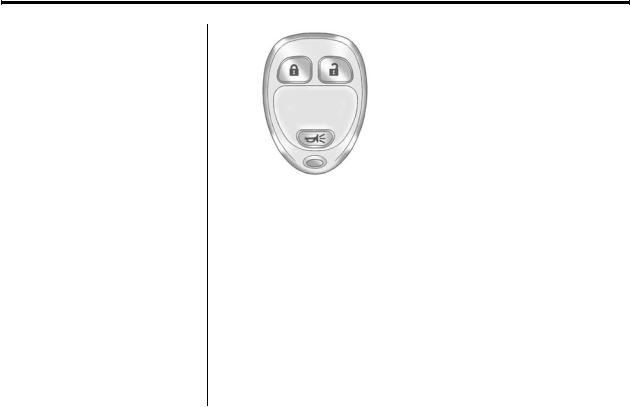
1-4 In Brief
Initial Drive
Information
This section provides a brief overview about some of the important features that may or may not be on your specific vehicle.
For more detailed information, refer to each of the features which can be found later in this owner manual.
Remote Keyless Entry
(RKE) System
The RKE transmitter functions work up to 20 m (65 ft) away from the vehicle.
Without Remote Start Shown, with Remote Start Similar
Q : Press to lock all the doors, including the liftgate.
K : Press once to unlock the driver door. If K is pressed again within five seconds, all remaining doors unlock.
L : Press and release to locate the vehicle. Press and hold L to
activate the panic alarm. Press L again to turn off the alarm.
See Keys on page 2-1 and Remote Keyless Entry (RKE) System Operation on page 2-2.
Remote Vehicle Start
This vehicle may have a remote starting feature that starts the engine from outside of the vehicle.
Starting the Engine Using
Remote Start
To start the vehicle:
1.Aim the RKE transmitter at the vehicle.
2.Press and release Q on the RKE transmitter.
3.Immediately after completing Step 2, press and hold / until the parking lamps flash. If the vehicle's lights can not be seen, press and hold / for at least four seconds.
When the vehicle starts, the parking lamps will turn on and remain on as long as the engine is running. The
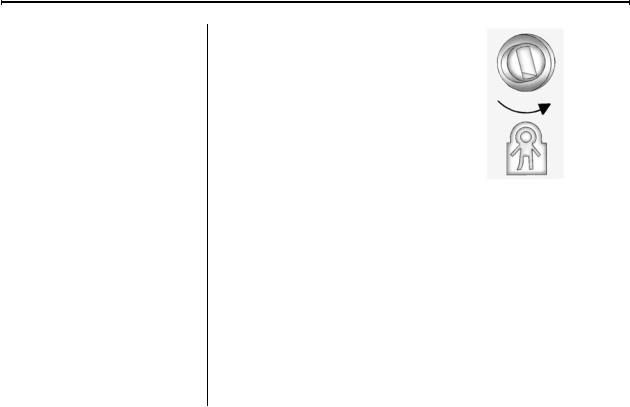
In Brief |
1-5 |
doors will be locked and the climate control system will operate at the same setting as when the vehicle was last turned off.
After entering the vehicle during a remote start, insert and turn the key to the ON/RUN position to drive the vehicle.
If the vehicle is left running, it automatically shuts off after
10 minutes unless a time extension has been done.
Shutting the Engine Off After a
Remote Start
To manually shut off a remote start:
.Aim the RKE transmitter at the vehicle and press / until the parking lamps turn off.
.Turn on the hazard warning flashers.
.Turn the ignition switch on and then off.
See Remote Vehicle Start on page 2-4.
Door Locks
From the outside, lock or unlock the door using the key or the Remote Keyless Entry (RKE) transmitter. See Remote Keyless Entry (RKE) System Operation on page 2-2.
From the inside, push or pull the manual door lock on each door.
Use the power door lock switch on the front doors.
Q : Press to lock the doors.
K : Press to unlock the doors.
See Door Locks on page 2-6 and Power Door Locks on page 2-6.
Safety Locks
The vehicle has rear door security locks to prevent passengers from opening the rear doors from the inside.
Open the rear doors to access the security locks on the inside edge of each door.
To activate, insert a key into the slot and turn it to the horizontal position. The door can only be opened from the outside.
To return the door to normal operation, open the door and turn the slot to the vertical position.

1-6 In Brief
Liftgate
To lock or unlock the liftgate from outside the vehicle, press Q or K twice on the Remote Keyless Entry (RKE) transmitter. See
Remote Keyless Entry (RKE) System Operation on page 2-2.
To lock or unlock the liftgate from inside the vehicle, press Q or K on the power door lock switch.
To open the liftgate, press the touch pad on the underside of the liftgate handle and pull up.
To close the liftgate, pull down using the handle and close until it latches.
See Liftgate on page 2-8.
Windows
Press the front of the switch to open the window. Pull the switch up to close it.
The power windows operate when the ignition is in ON/RUN or ACC/ ACCESSORY, or while in Retained Accessory Power (RAP). See
Retained Accessory Power (RAP) on page 9-18.
Express-Down Window
The driver window switch has an express-down feature that lowers the window without holding the switch. Press the switch part way and the window will open a small amount. Press the switch down all the way and release it and the window lowers all the way.
To stop the window while it is lowering, press and release the switch.
See Power Windows on page 2-13.
Window Lockout
This feature prevents the rear seat passengers from operating the windows. Press the lockout switch on the driver door panel to activate the switch. Press it again to deactivate the switch.
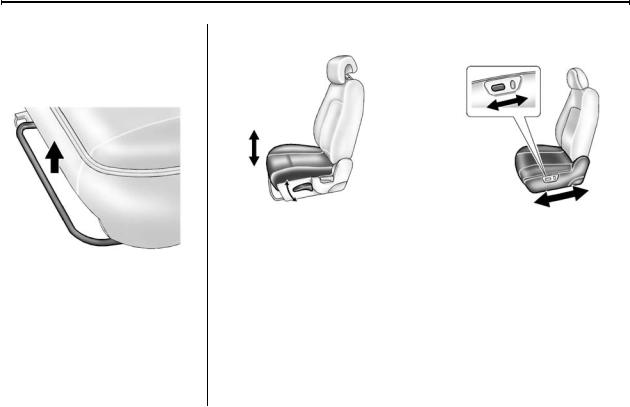
In Brief |
1-7 |
Seat Adjustment
Manual Seats
To adjust a manual seat:
1.Lift the bar to unlock the seat.
2.Slide the seat to the desired position and release the bar.
3.Try to move the seat back and forth to be sure the seat is locked in place.
Seat Height Adjuster |
Power Seats |
If available, move the lever up or down to raise or lower the seat.
See Seat Adjustment on page 3-3.
If available, move the control forward or rearward to adjust the seat position.
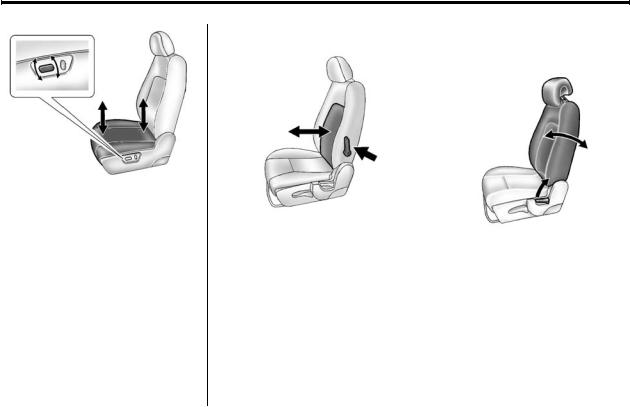
1-8 In Brief
To raise or lower the front or rear part of the seat cushion, move the front or rear of the control up
or down.
See Power Seat Adjustment on page 3-4.
Lumbar Adjustment |
Reclining Seatbacks |
|
Manual Reclining Seatbacks |
If available, move the lever forward or rearward to increase or decrease the lumbar support.
See Lumbar Adjustment on page 3-4.
To recline the seatback:
1.Lift the lever on the outboard side of the seat.
2.Move the seatback to the desired position, and then release the lever to lock the seatback in place.
3.Push and pull on the seatback to make sure it is locked.
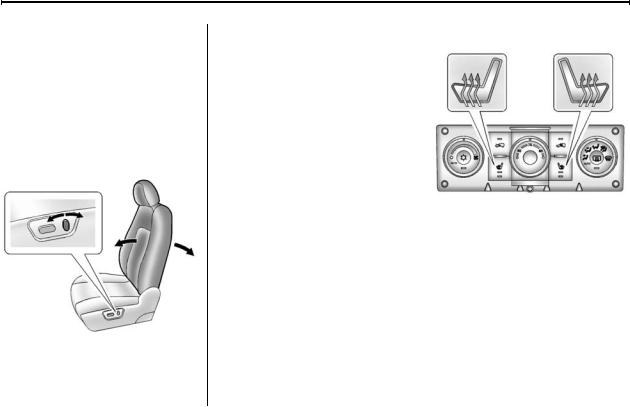
In Brief |
1-9 |
To return the seatback to the upright position:
1.Lift the lever fully without applying pressure to the seatback, and the seatback will return to the upright position.
2.Push and pull on the seatback to make sure it is locked.
Power Reclining Seatbacks
To adjust a power seatback, if equipped:
.Tilt the top of the control rearward to recline.
.Tilt the top of the control forward to raise.
See Reclining Seatbacks on page 3-5.
Second Row Seats
The rear seatbacks can be folded down to increase cargo space.
See Rear Seats on page 3-8.
Heated Seats
Automatic Climate Control System
Shown
If available, the buttons are on the climate control panel. To operate, the ignition must be on.
Press L or M to heat the driver or passenger seat cushion and seatback.
Press the button once for the highest setting. With each press of the button, the heated seat will change to the next lower setting,
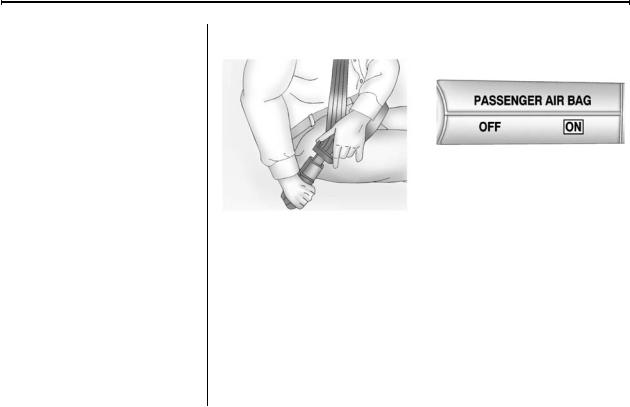
1-10 |
In Brief |
and then to the off setting. The lights indicate two for the highest setting and one for the lowest.
See Heated Front Seats on page 3-6.
Head Restraint
Adjustment
Do not drive until the head restraints for all occupants are installed and adjusted properly.
To achieve a comfortable seating position, change the seatback recline angle as little as necessary while keeping the seat and the head restraint height in the proper position.
See Head Restraints on page 3-2 and Seat Adjustment on page 3-3.
Safety Belts
Refer to the following sections for important information on how to use safety belts properly:
.Safety Belts on page 3-9.
.How to Wear Safety Belts Properly on page 3-11.
.Lap-Shoulder Belt on page 3-12.
.Lower Anchors and Tethers for Children (LATCH System) on page 3-38.
Passenger Sensing
System
The passenger sensing system will turn off the front outboard passenger frontal airbag under certain conditions. No other airbag is affected by the passenger sensing system.
The passenger airbag status indicator will light on the instrument panel when the vehicle is started. See Passenger Sensing System (United States) on page 3-24 for more information.
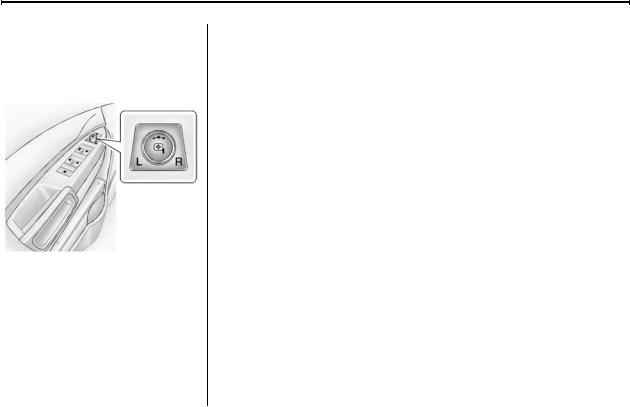
In Brief |
1-11 |
Mirror Adjustment
Exterior Mirrors
Power Outside Mirrors
To adjust the power mirrors:
1.Turn the knob to choose the left (L) or the right (R) mirror.
2.Use the knob to move the selected mirror so the side and the area behind the vehicle
is seen.
3.Return the control to the center position so the mirror cannot be moved.
Manual Folding Mirrors
The outside mirrors can be folded inward to prevent damage when going through an automatic car wash. To fold, pull the mirror toward the vehicle. Push the mirror outward to return it to the original position.
Automatic Dimming Feature
If equipped, the outside driver mirror automatically dims to reduce glare from vehicle headlamps. See
Automatic Dimming Rearview Mirror on page 2-13.
Interior Mirrors
Adjustment
Adjust the rearview mirror for a clear view of the area behind your vehicle.
Manual Rearview Mirror
If equipped, push the tab forward for daytime use and pull it for nighttime use to avoid glare from headlamps. See Manual Rearview Mirror on page 2-13.
Automatic Dimming Rearview
Mirror
If equipped, automatic dimming reduces the glare of the headlamps from behind. This feature comes on when the vehicle is started. See
Automatic Dimming Rearview Mirror on page 2-13.
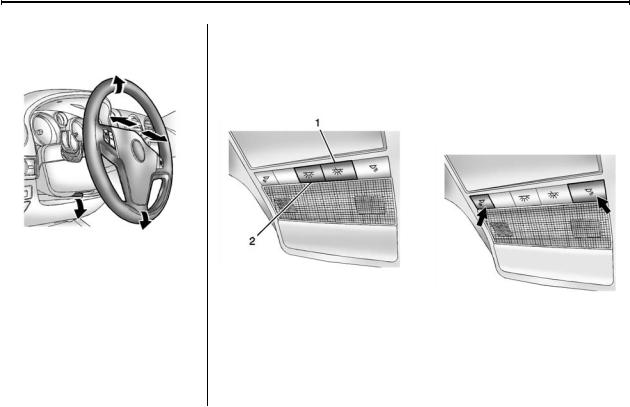
1-12 |
In Brief |
Steering Wheel
Adjustment
To adjust the steering wheel:
1.Hold the steering wheel and pull the lever down.
2.Move the steering wheel up or down.
3.Pull or push the steering wheel closer or away from you.
4.Pull the lever up to lock the steering wheel in place.
Do not adjust the steering wheel while driving.
Interior Lighting
Dome Lamps
There are front and rear dome lamps in the overhead console and the headliner.
* : Press the button (1) on the overhead console to keep the dome lamps and other interior lamps turned off while any door is open. Press this button again to return it to
the out position and the lamps automatically come on when any door is opened.
+ : Press the button (2) to turn the dome lamps on and off while the doors are closed.
Reading Lamps
The front reading lamps are in the overhead console.

In Brief |
1-13 |
The rear reading lamps are in the headliner.
To turn the reading lamps on or off, press the button next to each lamp.
Exterior Lighting
The exterior lamp control is on the instrument panel to the left of the steering wheel.
Turn the control to the following positions:
9 : Turns off the exterior lamps. The knob returns to the AUTO position after it is released.
AUTO: Automatically turns the exterior lamps on and off, depending on outside lighting.
; : Turns on the parking lamps including all lamps, except the headlamps.
2 : Turns on the headlamps together with the parking lamps and instrument panel lights.
See:
.Exterior Lamp Controls on page 6-1
.Turn and Lane-Change Signals on page 6-3
.Headlamp High/Low-Beam Changer on page 6-2
Windshield Wiper/Washer
The windshield wiper lever is on the right side of the steering column.
Move the lever up or down to select the wiper speed.
8: Single wipe, briefly move the lever down. The lever returns to its starting position when released. For several wipes, hold the lever down.
9: Turns the windshield wipers off.
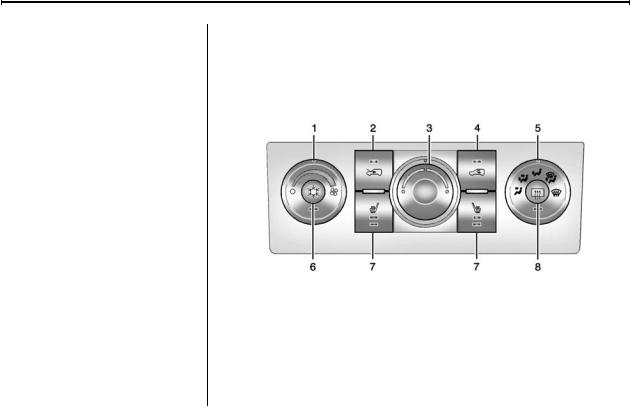
1-14 |
In Brief |
3: Sets a delay between wipes. Move the switch on top of the lever left for less frequent wipes or right for more frequent wipes.
a : Slow wipes.
1 : Fast wipes.
Windshield Washer
Pull the windshield wiper lever to spray windshield washer fluid and activate the wipers. The wipers will continue until the lever is released or the maximum wash time is reached.
Rear Window Wiper/Washer
The rear wiper and rear wash button is on the instrument panel above the climate control system.
= : Press to wash and wipe the rear window.
5 : Press to turn the delayed wiping on or off.
See Windshield Wiper/Washer on page 5-3 and Rear Window Wiper/ Washer on page 5-4.
Climate Controls
The heating, cooling, and ventilation for the vehicle can be controlled with this system. For vehicles with the remote start feature, the climate control system functions as part of the remote start feature. See Remote Keyless Entry (RKE) System Operation on page 2-2.
|
|
Climate Control System |
|
1. |
Fan Control |
6. |
Air Conditioning |
2. |
Outside Air |
7. |
Driver and Passenger Heated |
3. |
Temperature Control |
|
Seats (If Equipped) |
|
|
||
4. |
Recirculation |
8. |
Rear Window Defogger |
|
|
||
5. |
Air Delivery Mode Control |
|
|

In Brief |
1-15 |
Automatic Climate Control System
1.Fan Control
2.Outside Air
3.Temperature Control
4.Recirculation
5.Air Delivery Mode Control
6.Air Conditioning
7.Driver and Passenger Heated Seats (If Equipped)
8.Rear Window Defogger
See Climate Control Systems on page 8-1 or Automatic Climate Control System on page 8-5 (If Equipped).
Transmission
Electronic Range Select
(ERS) Mode
ERS mode allows you to choose the top-gear limit of the transmission and the vehicle's speed while driving downhill or towing a trailer. To use this feature:
1.Move the shift lever to M (Manual).

1-16 |
In Brief |
2.Press the plus/minus button located on the shift lever, to increase or decrease the gear range available.
See Manual Mode on page 9-23.
Vehicle Features
Radio(s)
O : Press to turn the system on and off. Turn to increase or decrease the volume.
BAND: Press to choose between FM, AM, or SiriusXM®, if equipped.
f : Select radio stations.
© SEEK or ¨ SEEK: Seek or scan stations.
4 (Information): If equipped with XM, MP3, WMA, or RDS features, press to display additional text information related to the current FM-RDS or SiriusXM station, or CD, MP3, or WMA song. Song title information will be displayed on the top line of the display while the artist information will be displayed on the bottom line, if the information is available during XM, CD, MP3,
or WMA playback. When information is not available, "No Info" displays.
For more information about these and other radio features, see
Operation on page 7-4.
Storing a Favorite Station
A maximum of 36 stations can be stored as favorites using the six softkeys below the radio station frequency tabs and by using the radio FAV button. Press FAV to go through up to six pages of favorites, each having six favorite stations available per page. Each page of favorites can contain any combination of AM, FM, or SiriusXM stations.
See Operation on page 7-4.
Setting the Clock
To set the time and date:
1.Turn the ignition key to ACC/ ACCESSORY or ON/RUN.
2.Press O to turn the radio on.
3.Press H and HR, MIN, MM, DD, and YYYY (hour, minute, month, day, and year) display.
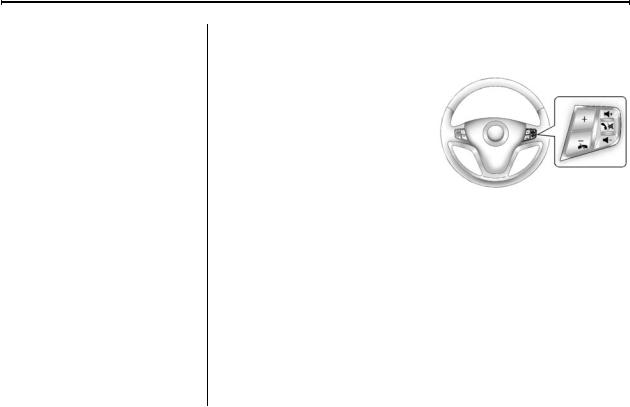
In Brief |
1-17 |
4.Press the softkey below the tab to be changed.
5.Increase or decrease the time or date by turning f clockwise or counterclockwise.
See Clock on page 5-6.
Satellite Radio
If equipped, SiriusXM® is a satellite radio service based in the
48 contiguous United States and
10 Canadian provinces.
SiriusXM satellite radio has a wide variety of programming and commercial-free music, coast to coast, and in digital-quality sound.
A fee is required to receive the SiriusXM service.
For more information, refer to:
.www.siriusxm.com or call 1-866-635-2349 (U.S.)
.www.xmradio.ca or call 1-877-209-0079 (Canada)
See Satellite Radio on page 7-6.
Portable Audio Devices
The vehicle may have a 3.5 mm (1/8 in) auxiliary input jack on the audio faceplate and a USB port in the center console. Some portable audio devices such as iPods®, MP3 players, and USB storage devices can be connected to the vehicle using a 3.5 mm (1/8 in) cable or a USB cable.
See Auxiliary Devices on page 7-20.
Bluetooth®
If equipped with a Bluetooth system, it allows users with a Bluetooth-enabled cell phone to make and receive hands-free calls using the vehicle’s audio system and controls.
The Bluetooth-enabled cell phone must be paired with the Bluetooth system before it can be used in the vehicle. Not all phones will support all functions. For more information, see www.gm.com/bluetooth and
Bluetooth on page 7-24.
Steering Wheel Controls
For vehicles with audio steering wheel controls, some audio controls can be adjusted at the steering wheel.
+ / −: Press and release to go to the next or the previous preset radio station or CD track.
J / 0 : For vehicles with Bluetooth® and OnStar®, press and hold to interact with those systems. Press and release to mute the system. Press it again to turn the sound back on.
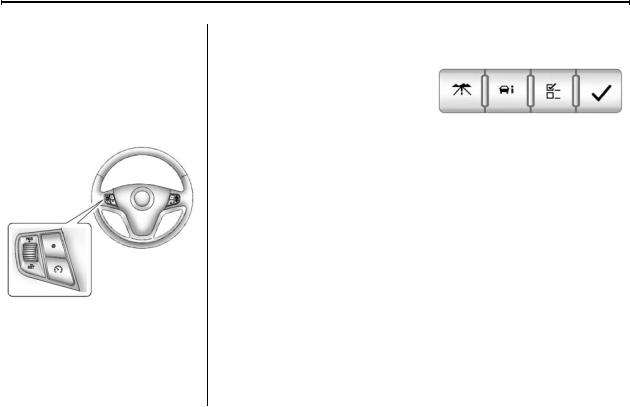
1-18 |
In Brief |
K : Press to reject an incoming call, or end a current call.
v + or v −: Move the thumbwheel up or down to increase or to decrease the volume.
Cruise Control
E : Press to turn the cruise control system on and off. The indicator light on the button turns on or off.
RES+: Move the thumbwheel up briefly to make the vehicle resume to a previously set speed or hold
upwards to accelerate. If cruise control is already active, use to increase vehicle speed.
−SET: Move the thumbwheel down briefly to set the speed and activate cruise control. If cruise control is already active, use to decrease speed.
See Cruise Control on page 9-30.
Infotainment System
If the vehicle has a base radio it is included in this manual. See the infotainment manual for information on the connected radios, audio players, phone, navigation system, settings, and voice or speech recognition.
Driver Information
Center (DIC)
The DIC has different displays in the instrument cluster which can be accessed by pressing the DIC buttons on the instrument panel, below the exterior lamps control.
DIC Buttons
3 : Press to display the trip and fuel displays.
T: Press to display the vehicle information displays.
U : Press to customize the feature settings on the vehicle. See Vehicle Personalization on page 5-36 for more information.
V : Press to set or reset certain functions and to turn off or acknowledge messages on the DIC.
See Driver Information Center (DIC) on page 5-24.
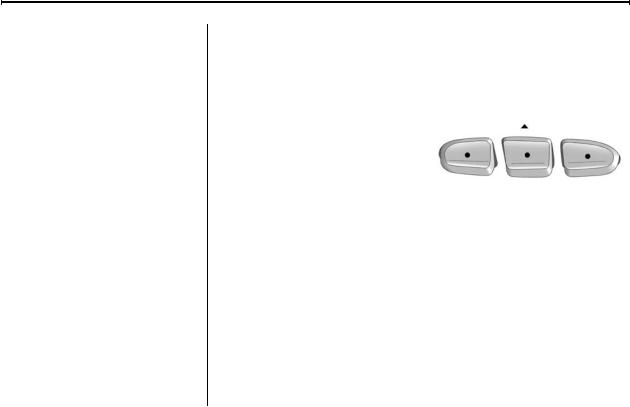
In Brief |
1-19 |
Vehicle Personalization
Some vehicle features can be programmed by using the DIC buttons on the instrument panel to the left of the steering wheel. These features include:
.Language
.Door Lock and Unlock Settings
.Lighting
.Chime Volume
.Remote Start
See Vehicle Personalization on page 5-36.
Rear Vision
Camera (RVC)
If equipped, RVC displays a view of the area behind the vehicle, on the center stack display, when the vehicle is shifted into R (Reverse).
See Rear Vision Camera (RVC) on page 9-34.
Ultrasonic Parking Assist
If equipped, this system uses sensors on the rear bumper to assist with parking and avoiding objects while in R (Reverse).
It operates at speeds less than 8 km/h (5 mph). Ultrasonic Rear
Parking Assist (URPA) uses audible beeps to provide distance and system information.
Keep the sensors on the vehicle's rear bumper clean to ensure proper operation.
See Ultrasonic Parking Assist on page 9-32.
Power Outlets
The accessory power outlets can be used to plug in electrical equipment, such as a cell phone or MP3 player.
The power outlets are located inside the center floor console, on the rear of the center floor console, and in the rear cargo compartment.
Remove the cover to access and replace when not in use.
See Power Outlets on page 5-7.
Universal Remote System
The Universal Home Remote System allows for garage door openers, security systems, and home automation devices to be programmed to work with these buttons in the vehicle.
See Universal Remote System on page 5-42.

1-20 |
In Brief |
Performance and
Maintenance
Traction Control/
Electronic Stability
Control
The Traction Control System (TCS) limits wheel spin. The system turns on automatically every time the vehicle is started.
The StabiliTrak system assists with directional control of the vehicle in difficult driving conditions. The system also turns on automatically every time the vehicle is started.
.To turn off or on TCS, press and release the TCS/StabiliTrak button g on the instrument panel. The appropriate DIC message displays.
.To turn off both Traction Control and StabiliTrak, press and hold the TCS/StabiliTrak button g until the StabiliTrak Off light g illuminates and the appropriate DIC message displays.
.Press the TCS/StabiliTrak button g again to turn on both systems. The appropriate DIC message displays.
See Traction Control/Electronic Stability Control on page 9-28.
This vehicle also has a Brake Pedal Override feature that limits engine torque when the brake pedal is applied. See Traction Control/ Electronic Stability Control on
page 9-28.
Tire Pressure Monitor
This vehicle may have a Tire Pressure Monitor System (TPMS).
The low tire pressure warning light alerts to a significant loss in pressure of one of the vehicle's tires. If the warning light comes on, stop as soon as possible and inflate the tires to the recommended pressure shown on the Tire and Loading Information label. See
Vehicle Load Limits on page 9-10. The warning light will remain on until the tire pressure is corrected.
The low tire pressure warning light may come on in cool weather when the vehicle is first started, and then turn off as the vehicle is driven. This may be an early indicator that the

In Brief |
1-21 |
tire pressures are getting low and the tires need to be inflated to the proper pressure.
The TPMS does not replace normal monthly tire maintenance. Maintain the correct tire pressures.
See Tire Pressure Monitor System on page 10-46.
Engine Oil Life System
The engine oil life system calculates engine oil life based on vehicle use and displays a CHANGE ENGINE OIL SOON message when it is time to change the engine oil and filter.
Resetting the Oil Life System
Reset the system whenever the engine oil is changed so that the system can calculate the next engine oil change. To reset the system:
1.Display OIL LIFE REMAINING on the DIC. See Driver Information Center (DIC) on page 5-24 and Engine Oil Messages on page 5-31.
2.Press V for five seconds to reset the oil life at 100%.
Be careful not to reset the oil life display accidentally at any time other than after the oil is changed. It cannot be reset accurately until the next oil change.
The oil life system can also be reset as follows:
1.Turn the ignition key to ON/RUN with the engine off.
2.Fully press and release the accelerator pedal three times within five seconds.
If the OIL LIFE REMAINING value is not 100%, the system needs to be reset again.
See Engine Oil Life System on page 10-10.
E85 or FlexFuel
Vehicles with a yellow fuel cap can use either unleaded gasoline or ethanol fuel containing up to 85% ethanol (E85). See E85 or FlexFuel on page 9-37. For all other vehicles, use only the unleaded gasoline described under Recommended Fuel on page 9-36.
Driving for Better Fuel Economy
Driving habits can affect fuel mileage. Here are some driving tips to get the best fuel economy possible.
.Avoid fast starts and accelerate smoothly.
.Brake gradually and avoid abrupt stops.
.Avoid idling the engine for long periods of time.
.When road and weather conditions are appropriate, use cruise control.

1-22 |
In Brief |
.Always follow posted speed limits or drive more slowly when conditions require.
.Keep vehicle tires properly inflated.
.Combine several trips into a single trip.
.Replace the vehicle's tires with the same TPC Spec number molded into the tire's sidewall near the size.
.Follow recommended scheduled maintenance.
Roadside Assistance
Program
U.S.: 1-800-243-8872
TTY Users (U.S. Only): 1-888-889-2438
Canada: 1-800-268-6800
New Chevrolet owners are automatically enrolled in the Roadside Assistance Program.
See Roadside Assistance Program on page 13-5.
OnStar®
If equipped, this vehicle has a comprehensive, in-vehicle system that can connect to a live Advisor for Emergency, Security, Navigation, Connection, and Diagnostic Services. See OnStar Overview on page 14-1.

Keys, Doors, and Windows 2-1
Keys, Doors, and
Windows
Keys and Locks
Keys . . . . . . . . . . . . . . . . . . . . . . . . . . 2-1
Remote Keyless Entry (RKE)
System . . . . . . . . . . . . . . . . . . . . . . 2-2
Remote Keyless Entry (RKE)
System Operation . . . . . . . . . . . 2-2
Remote Vehicle Start . . . . . . . . . 2-4
Door Locks . . . . . . . . . . . . . . . . . . . 2-6
Power Door Locks . . . . . . . . . . . . 2-6
Delayed Locking . . . . . . . . . . . . . . 2-6
Automatic Door Locks . . . . . . . . . 2-6
Lockout Protection . . . . . . . . . . . . 2-7
Safety Locks . . . . . . . . . . . . . . . . . . 2-7
Doors
Liftgate . . . . . . . . . . . . . . . . . . . . . . . . 2-8
Vehicle Security
Vehicle Security . . . . . . . . . . . . . . . 2-9
Vehicle Alarm System . . . . . . . . . 2-9
Immobilizer . . . . . . . . . . . . . . . . . . 2-10
Immobilizer Operation . . . . . . . 2-10
Exterior Mirrors
Convex Mirrors . . . . . . . . . . . . . . 2-11
Power Mirrors . . . . . . . . . . . . . . . . 2-12
Folding Mirrors . . . . . . . . . . . . . . . 2-12
Heated Mirrors . . . . . . . . . . . . . . . 2-12
Automatic Dimming Mirror . . . 2-12
Interior Mirrors
Interior Rearview Mirrors . . . . . 2-13
Manual Rearview Mirror . . . . . . 2-13
Automatic Dimming Rearview
Mirror . . . . . . . . . . . . . . . . . . . . . . . 2-13
Windows
Windows . . . . . . . . . . . . . . . . . . . . . 2-13
Power Windows . . . . . . . . . . . . . 2-13
Sun Visors . . . . . . . . . . . . . . . . . . . 2-14
Roof
Sunroof . . . . . . . . . . . . . . . . . . . . . . 2-14
Keys and Locks
Keys
{Warning
Leaving children in a vehicle with the ignition key is dangerous and children or others could be seriously injured or killed. They could operate the power windows or other controls or make the vehicle move. The windows will function with the keys in the ignition, and children or others could be caught in the path of a closing window. Do not leave children in a vehicle with the ignition key.
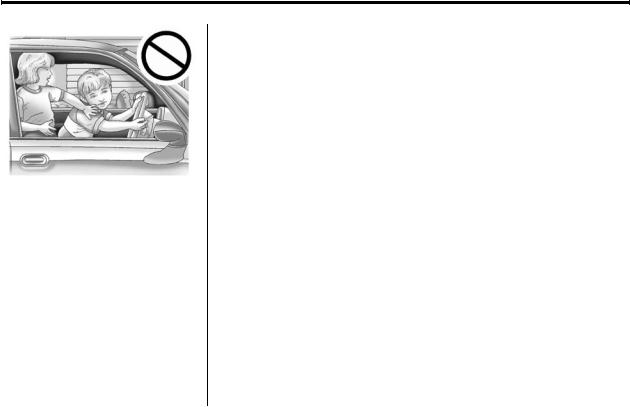
2-2 Keys, Doors, and Windows
The two keys can be used for the ignition and all locks.
The key code is stamped on the key number plate and can be used to make new keys at any dealer. Store this information in a safe place outside the vehicle.
If it becomes difficult to turn a key, inspect the key blade for debris. Periodically clean with a brush
or pick.
If equipped, with an active OnStar subscription, an OnStar Advisor may remotely unlock the vehicle. See “OnStar” if equipped.
Remote Keyless Entry
(RKE) System
See Radio Frequency Statement on page 13-15.
If there is a decrease in the RKE operating range:
.Check the distance. The transmitter may be too far from the vehicle.
.Check the location. Other vehicles or objects may be blocking the signal.
.Check the transmitter's battery. See “Battery Replacement” later in this section.
.If the transmitter is still not working correctly, see your dealer or a qualified technician for service.
Remote Keyless Entry
(RKE) System Operation
The Remote Keyless Entry (RKE) transmitter functions work up to 20 m (65 ft) away from the vehicle.
Some conditions can affect the performance of the transmitter. See
Remote Keyless Entry (RKE) System on page 2-2.
